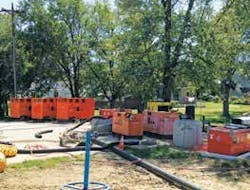Project
Sanitation District No. 1 of Northern Kentucky (SD1) needed to perform wet well concrete rehabilitation to two pump stations in Covington, Kentucky, located just across the Ohio River from Cincinnati. The Eighth Street pump station is designed to pump up to 26.3 million gallons per day (MGD) under normal conditions and 28.5 MGD during flood events, while the Patton Street pump station is designed to pump up to 12.8 MGD under normal conditions and 20.1 MGD during flood events.
While the stations were being rehabilitated, the wastewater that would typically be routed through them needed to be bypassed using alternative pumping solutions. Each wet well is more than 28 ft deep, necessitating the use of submersible equipment. In addition, the engineering firms associated with this project required contractors to provide constant remote monitoring while the bypass system was in use, as well as facilitate the ability to monitor the sump level and adjust the pumps’ output according to flow conditions. The contractors would also need to make sure that the bypass system would not create excessive amounts of noise and disturb area residents.
Solution
Xylem’s sales team submitted bypass solutions to SD1 and the engineering firms prior to the project bid date. The proposal included hydraulically-driven submersible pumps, fully integrated with Godwin Field Smart Technology (FST), and turnkey installation, service and removal.
For the Eighth Street pump station project, Xylem recommended Critically Silenced Godwin Heidra pumps controlled by level transducers: three HS150 pumps, one HS200 pump and four HS300 pumps. Because of the depth of the suction point and the difficulty workers would have accessing the units, the HS300 pump ends would be equipped with remote Venturi systems, while the HS150 and HS200 units would be situated at the bottom of the pits.
Xylem also specified Critically Silenced Godwin Heidra pumps with level transducers for the Patton Street pump station project: one HS100 pump, one HS150 pump and three HS300 pumps. As with the Eighth Street station, the HS300 pump ends would be equipped with remote Venturi systems due to the depth of the suction point and the restricted access. The Venturi systems would be powered by primary and backup air compressors.
Dugan & Meyers Construction Co. submitted the lowest bids for both projects and chose to proceed with Xylem’s bypass plan, despite the fact that it was not the least expensive solution available. “Our opportunity for success on this project relied almost exclusively on the performance of the bypass system and support thereof,” said Jason M. Fisher, Project Executive for Dugan & Meyers. “Because of this, we knew that we had to select the right partner who could handle the challenge.”
According to Fisher, Xylem was chosen because it provided the ability to handle both pump station bypasses, simplifying the project by providing a single point of contact. In addition, Xylem worked with Dugan & Meyers to creatively adapt the project during the scope review period, and provided the continuous monitoring services the project engineers required as part of the FST remote monitoring package.
“The biggest thing that set us apart on this project versus our competition was our FST system, giving the contractor the ability to—through the Internet—monitor the pumping system,” said Norm Rolf, Project Sales Representative for Xylem. “They could act on the pumping system and receive notifications if there were any problems with the pumps at any given time. This allowed them to not need someone on site 24/7 while maintaining optimum system operations, since this was a very high-profile project.”
Results
The installation and startup of Xylem’s Godwin pumps at the Patton Street pump station occurred in August 2015. The day after startup, Covington received heavy rainfall of more than two inches within one hour. The system performed flawlessly and has continued to do so ever since. “Everything is running well, and we are very pleased with the system performance so far,” said Fisher.
For the Eighth Street pump station, installation and startup were completed in mid-September through October. “To me, this project is just another job that we put on the ground,” said Joe Herbst, Branch Manager for Xylem. “This is what we do.”
Editor's Note: Scranton Gillette Communications and the SGC Water Group are not liable for the accuracy, efficacy and validity of the claims made in this piece. The views expressed in this content do not reflect the position of the editorial teams of Water & Wastes Digest, Water Quality Products and Storm Water Solutions.


